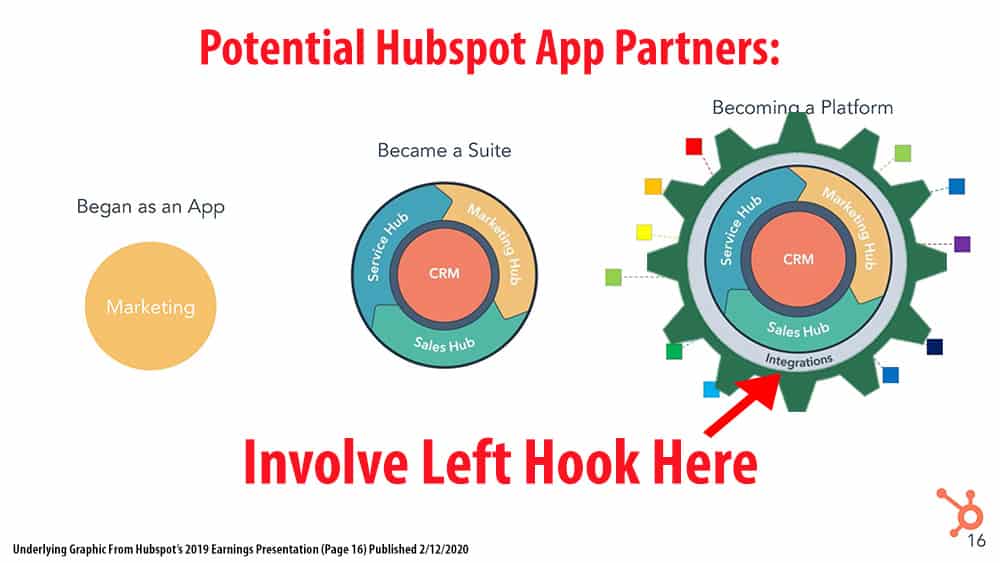The HubSpot Partner Ecosystem: Early Observations from a HubSpot Developer (Part 2 of 2)
By

As covered in Part 1 of our HubSpot Partner Ecosystem Opportunity Review, HubSpot is making a big bet on its transition from app to suite to marketplace.
HubSpot’s Marketplace offers a golden opportunity for SaaS leaders, with over 73,000 HubSpot customers heavily engaged in discovering apps there.
In this Part 2, we offer six observations on the HubSpot Partner Ecosystem, and some guidance on how SaaS leaders can take full advantage to grow their SaaS.
Early Observations from a HubSpot App Developer
First, allow me a quick contextual humble-brag to explain how and why Left Hook comes by these observations:
- We built our first HubSpot app in 2019 for FreshBooks. (You can learn more about the app’s features in depth in its marketplace listing)
- We’re working on a second app now (client undisclosed), with more in the pipeline
- Our core business is building 20+ different universal integrations for SaaS companies, which gives us a broad view on developer platforms (good and bad)
On a weekly basis we view the HubSpot opportunity through the eyes of many different potential partners, each with their own goals and technical capabilities.
We guide these SaaS leaders through an assessment process to determine if/how the HubSpot ecosystem is a good match for their own integration strategy.
With that context in mind, here’s some early and general observations about becoming a HubSpot App Partner:
#1: Define Success First
General wisdom! Even a relatively simple HubSpot App takes a significant investment of time and resources, with long-term support and improvements required.
It’s important to articulate why you think a HubSpot integration will be valuable. When internal audiences see the cost of a quality app, you’ll need that good thinking to make your case.
We help our clients define integration success by asking these leading questions:
Is your goal to:
- Please existing customers by solving well-defined use cases?
- Close potential leads that need (or think they need) a Hubspot integration?
- Generate new prospects through a Hubspot’s Marketplace listing?
- Proactively co-market with Hubspot (i.e. more than a simple listing)?
- Encourage Hubspot salespeople to promote your integration?
- Fill a functionality gap in your own product?
Once you’ve identified your goals, then we ask: what weight do you put on each? Are some more important than others?
And a final question: what metrics will you use to prove back success to your internal audiences?
(We’d love to help you think this through!)
#2: Hubspot’s High Bar: Quality is King
To get the most marketing benefit out of your Hubspot partnership, you need a certified integration.
In our experience, this certification process is rigorous. Hubspot is not in a hurry to promote a mediocre or risky app. Quality is King.
For example, Hubspot now requires your app to be listed in the marketplace for at least six months before they even evaluate your app for potential certification. Security and API efficiency are important considerations in their review process, as is your team’s responsiveness to user feedback.
Back to #1. If your goal is to leverage the Hubspot marketplace with an quick MVP app, stop right here. Hubspot’s Certified App Rewards do not unlock quickly or easily.
If your goal is to solve use cases for existing customers or leads, then Hubspot’s “quality before promotion” approach won’t be an impediment. Your integration will be listed and will work for them immediately (though Hubspot will still monitor and remove problematic apps.)
#3: Many Features, Many Flavors
Hubspot allows for many different integration scenarios, including:
- Bulk uploading contacts and other types of spreadsheet-based data
- Bi-directional data movement and syncing to the CRM and Marketing/Service Hubs
- Robust event-based workflows
- CRM Extensions (covered in depth in #4 below)
Before getting excited, you’ll need to evaluate your app’s technical readiness for these scenarios (i.e. can your API deliver ready-to-integrate data.)
You’ll also want to understand how to build scaleable middleware solutions to handle authentication and orchestration. (This is Left Hook’s sweet spot. Chat with us if outsourcing is on your mind.)
#4: CRM Extensions are Super Cool
At the center of the Hubspot platform is it’s CRM, the “system for managing customer relationships and a central place to store data your business needs to grow.”
Hubspot wants companies to live inside the CRM, and use it as their system of record. That’s why the developer platform offers several ways for end-users to take action, consume information, or trigger external events from within the CRM UI.
These various UI-based tools are called “CRM Extensions.” And they are the creamy center of the Hubspot platform experience.
To illustrate, here’s an app we’re developing right now: imagine your SaaS is an e-signature tool. You know many of your best customers are sales teams that focus inside Hubspot’s CRM all day long. Wouldn’t it be wicked awesome if those reps could access agreement templates, merge in prospect data, send documents out for signature, and see signature status updates, all from within the CRM UI?
To achieve this rich user experience, we are leveraging several Hubspot APIs, as well as iframes and UI elements knowns as “cards” to display data and enable actions contextually (i.e. from w/in a particular contact’s CRM record.)
You can also check out the CRM extensions we built for FreshBooks, which include invoice details displayed within a contact record, timeline event(s) to show you when a contact pays their bill, and quick links to the full invoice, all accessed within the Hubspot CRM UI.
If your mutual customers prefer to consume your SaaS inside the Hubspot CRM, then extensions offer a powerful opportunity to simplify and speed up their workflow. Nothing pleases a salesperson more than closing a deal faster with less work (i.e. learning/managing two different SaaS tools.)
If you’d like some help getting a CRM extension planned and launched, we’re here for you!
#5. PieSync, Zapier, and your Raison D’Etre
 You see the potential for a Hubspot App. But do you really need one to achieve your goals? Is there a faster, cheaper way?
You see the potential for a Hubspot App. But do you really need one to achieve your goals? Is there a faster, cheaper way?
The integration landscape is getting crowded and complicated, with an over-supply of acronymic pretty things. But TBH, there’s a reasonable chance that an existing tool might solve your customer’s pressing use with minimal development effort.
Again, Return to #1:
A. Is marketing/distribution/exposure your goal?
B. Or do you just need a workable solution to satisfy existing users?
If you chose “B,” then we might recommend exploring two well-known integration platforms: Zapier and PieSync (now owned by Hubspot, though still in the early days of assimilating to the mothership.)
Zapier makes it easy for an end-customer to build a multi-step workflow that triggered from inside your app, the Hubspot CRM, or even a third app. With 2,000+ apps and reasonable subscription prices, Zapier is one of our favorite integration tools.
(Note that we’ve launched 60+ public apps on behalf of our SaaS clients, who find their Zapier partnership highly valuable. Hubspot certainly does- see its robust Zapier app!)
 PieSync is a little more niche, but it solves a hard problem: continuously syncing data between two SaaS systems, with deduplication and conflict management built-in and user-friendly.
PieSync is a little more niche, but it solves a hard problem: continuously syncing data between two SaaS systems, with deduplication and conflict management built-in and user-friendly.
While it doesn’t offer SaaS partners a development platform like Zapier, PieSync is a rcase-specific, expensive, but mad useful solution. (In general, bi-directional syncing is wicked hard, and worth the extra money to get right.)
[Note that Left Hook can build a similar syncing function into your Hubspot app, if you want to offer this along with a CRM extension.]
Integration platforms like Zapier and Piesync are excellent, but you can’t have everything. (Where would you put it?) There are downsides to consider.
For one thing, end-customers aren’t crazy about you pushing costs on to them through “yet another subscription.” Our friends at ProfitWell have studied this “willingness to pay” dynamic, and it’s not a great story for third-party integration tools.
Integration platforms frequently require professional services to efficiently implement, adding friction and more cost.
Some SaaS companies object to being intermediated by third-party integration platforms. They don’t like losing control of the user experience, the data, and the customer’s affection gained by solving a problem that many view as “table stakes” in 2020.
Other SaaS leaders are happy to make the trade. And many decide to offer both options.
Our advice is to understand the pros and cons, and make thoughtful choices that support your overall integration strategy. (We’re here to help guide you.)
#6. Your Hubspot Partner App is a Product, not a Project
More general wisdom: no universal integration is a “project.”
We meet SaaS leaders all the time who struggle to accept the reality that integrations are SaaS products, too.
Just like their core SaaS product, universal integrations require attention, iteration, customer support, and ongoing management to remain valuable over time.
We’ve witnessed what happens when SaaS leaders apply a “project” mentality to a new integration app. Marketing never gets around to promoting it. Sales people don’t get their heads around selling it. The customer success team can’t answer basic questions about how to use it.
Eventually the integration stops working. Customers complain. Everybody get bitter about the time and money spent.
If you’re serious about investing in a Hubspot Partner App, get ahead of this train-wreck.
Set reasonable expectations with your management. Budget staff hours for marketing, user feedback gathering, and sales training every six months.
We see this failure scenario play out every day. We also see companies think of integrations like a product, and then love the results and ROI.
Want to be the latter? We’re happy to help you plan and execute!

